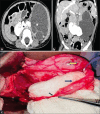Rare Association of Ureteral Atresia in a Horseshoe Kidney: A Case Report and Review of Literature
- PMID: 40756043
- PMCID: PMC12316432
- DOI: 10.4103/jiaps.jiaps_192_24
Rare Association of Ureteral Atresia in a Horseshoe Kidney: A Case Report and Review of Literature
Abstract
Ureteral atresia is a rare congenital anomaly of the ureter often associated with renal dysplasia. We report a case showing the rare occurrence of ureteral atresia and horseshoe kidney in a 1-year-old male, presenting with a flank mass. The report aims to contribute to the existing literature on pediatric renal anomalies by detailing the diagnostic process, surgical intervention, and subsequent outcomes in the context of this complex presentation.
Keywords: Congenital anomalies of the kidney and urinary tract; horseshoe kidney; hydronephrosis; ureteral atresia.
Copyright: © 2025 Journal of Indian Association of Pediatric Surgeons.
Conflict of interest statement
There are no conflicts of interest.
Figures


Similar articles
-
A case report on atypically presented Congenital Solitary pelvic kidney with neglected Ureteropelvic junction obstruction (UPJO) successfully managed with open Anderson-Hynes pyeloplasty. Case report.Int J Surg Case Rep. 2025 Aug;133:111603. doi: 10.1016/j.ijscr.2025.111603. Epub 2025 Jul 4. Int J Surg Case Rep. 2025. PMID: 40633133 Free PMC article.
-
Retrocaval ureter in a 6-year-old child presenting with isolated right flank pain: A case report from Syria.Int J Surg Case Rep. 2025 Aug;133:111525. doi: 10.1016/j.ijscr.2025.111525. Epub 2025 Jun 21. Int J Surg Case Rep. 2025. PMID: 40554939 Free PMC article.
-
Managing Pyeloureteral Atresia in Pediatrics: A Case of Right-Sided Hydronephrosis and Surgical Intervention.Am J Case Rep. 2025 Jun 22;26:e947597. doi: 10.12659/AJCR.947597. Am J Case Rep. 2025. PMID: 40544326 Free PMC article.
-
Management of urinary stones by experts in stone disease (ESD 2025).Arch Ital Urol Androl. 2025 Jun 30;97(2):14085. doi: 10.4081/aiua.2025.14085. Epub 2025 Jun 30. Arch Ital Urol Androl. 2025. PMID: 40583613 Review.
-
The presentation and management of complex female genital malformations.Hum Reprod Update. 2016 Jan-Feb;22(1):48-69. doi: 10.1093/humupd/dmv048. Epub 2015 Nov 3. Hum Reprod Update. 2016. PMID: 26537987
Cited by
-
Proximal Ureteral Atresia in a Caribbean Neonate With Multicystic Dysplastic Kidney.Cureus. 2025 Jul 31;17(7):e89113. doi: 10.7759/cureus.89113. eCollection 2025 Jul. Cureus. 2025. PMID: 40896043 Free PMC article.
References
-
- Weizer AZ, Silverstein AD, Auge BK, Delvecchio FC, Raj G, Albala DM, et al. Determining the incidence of horseshoe kidney from radiographic data at a single institution. J Urol. 2003;170:1722–6. - PubMed
-
- Hedden R, Wacksman J, Sheldon C. Complete nonunion of the ureterovesical junction with preservation of renal function. J Urol. 1994;151:1361–2. - PubMed
-
- Zundel S, Szavay P, Schaefer JF, Amon O, Fuchs J. Single kidney and ureteral atresia in a newborn girl: A treatment concept. J Pediatr Urol. 2011;7:576–8. - PubMed
Publication types
LinkOut - more resources
Full Text Sources
